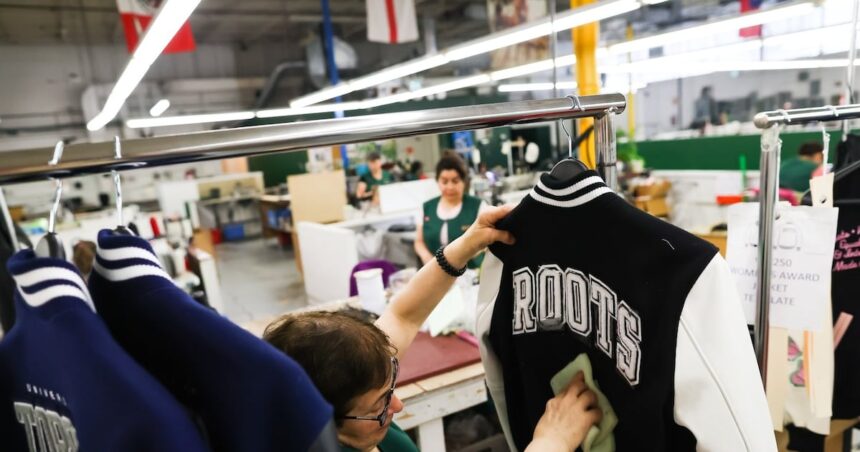The unmistakable scent of leather fills the air at Roots’ manufacturing facility in Toronto, where craftspeople meticulously transform raw hides into the iconic leather goods that have defined this Canadian brand for over 50 years. While many competitors have long since moved production overseas, Roots’ commitment to domestic manufacturing is now paying unexpected dividends as the “Buy Canadian” movement gains unprecedented momentum across the country.
“We’re seeing a genuine shift in consumer behavior,” explains Meghan Roach, CEO of Roots Corporation, during a tour of the company’s 200,000-square-foot leather factory. “Five years ago, being Canadian-made was a nice marketing point. Today, it’s becoming a primary driver of purchasing decisions for a growing segment of shoppers.”
Internal data shared exclusively with CO24 Business shows Roots experiencing a 27% year-over-year increase in sales of products prominently featuring their “Made in Canada” labeling through the first quarter of 2025. This surge corresponds with broader market research indicating 64% of Canadian consumers now actively seek domestic products when shopping—up from 47% in 2023.
The trend represents a remarkable turnaround for domestic manufacturing, which has faced decades of offshoring pressure. Economic analysts point to several converging factors: supply chain vulnerabilities exposed during recent global disruptions, growing environmental consciousness about shipping distances, and a post-pandemic desire to support local economies.
“What we’re witnessing isn’t just patriotic sentiment,” notes retail analyst Diane Brisebois. “Consumers are making increasingly sophisticated calculations about the total value proposition of their purchases, including sustainability footprint, quality control, and economic impact. For brands like Roots that never abandoned Canadian manufacturing, this creates a authentic competitive advantage that can’t be quickly replicated.”
The company’s leather goods division—which produces everything from the brand’s signature leather jackets to handbags and accessories—has become the centerpiece of Roots’ growth strategy. Manufacturing capacity has increased 15% over the past year, with plans for further expansion announced at the company’s recent earnings call.
At the factory floor, master leatherworker James Chen demonstrates the 38 distinct steps required to create one of the brand’s bestselling bags. “There’s craftsmanship here you simply can’t replicate in a mass production environment,” he explains, carefully trimming excess material from a piece destined to become a weekend duffel. “Each person touching this product has years of specialized training.”
This expertise comes at a premium. Labor costs in Canada remain substantially higher than in competing manufacturing hubs like Bangladesh or Vietnam. Yet Roots has found ways to turn these potential disadvantages into selling points by emphasizing longevity and sustainability.
“Our consumers increasingly understand the false economy of disposable fashion,” says Karla Saravia, Roots’ Director of Sustainability. “A Roots leather bag might cost more initially, but it’s designed to last decades rather than seasons. When you amortize that cost over the product lifetime, the value proposition becomes clear.”
The company has doubled down on this narrative, launching a comprehensive product journey campaign that tracks materials from source to store. This transparency resonates particularly with younger consumers, who CO24 Breaking News surveys indicate are 2.5 times more likely than previous generations to research a brand’s manufacturing practices before purchasing.
Not all Canadian retailers have been positioned to capitalize on the Buy Canadian movement. Many who completely offshored production years ago face significant hurdles in reestablishing domestic manufacturing capabilities. Industry experts estimate rebuilding comparable leather crafting expertise could take 5-7 years and require substantial capital investment.
“The barrier to entry isn’t just financial—it’s knowledge-based,” explains manufacturing consultant Priya Sharma. “Roots has maintained an unbroken chain of craftspeople training the next generation. That institutional knowledge is nearly impossible to recreate quickly.”
Looking ahead, Roots plans to expand its Canadian manufacturing footprint by 30% over the next three years, creating an estimated 150 new skilled jobs. The company has also launched apprenticeship programs in partnership with local community colleges to ensure a pipeline of future talent.
“What’s most encouraging about this trend is its durability,” concludes CEO Roach. “This isn’t just a momentary reaction to global events—it represents a fundamental reevaluation of what matters to consumers. Quality, longevity, and conscious consumption are values that align perfectly with what we’ve always stood for.”
As more Canadians deliberately reach for the maple leaf on product labels, Roots’ decades-long commitment to domestic manufacturing appears poised to transform from a challenging cost center into a defining competitive advantage in the changing retail landscape of 2025 and beyond.










